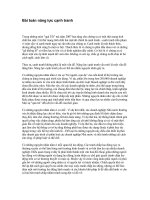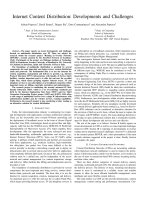Tài liệu FMCG (Fast Moving Consumer Goods) Sector ppt
Bạn đang xem bản rút gọn của tài liệu. Xem và tải ngay bản đầy đủ của tài liệu tại đây (663.37 KB, 7 trang )
FMCG (Fast Moving Consumer Goods) Sector
Analyst: Ms. Binal R. Vora
Indian FMCG sector
is the fourth largest sector in
the economy characterized by
strong MNC presence, well
established distribution
network, intense competition
between the organised and
unorganised players and low
operational cost. Easy
availability of important raw
materials, cheaper labor costs
and presence across the entire
value chain gives India a
competitive advantage.
Penetration level and per
capita consumption in many
product categories is very low
compared to world average
standards representing the
unexploited market potential.
Mushrooming Indian
population, particularly the
middle class and the rural
segments, presents the huge
untapped opportunity to
FMCG players.
he Indian FMCG sector is the fourth largest sector in the economy with an
estimated size of Rs.1,300 billion. The sector has shown an average annual
growth of about 11% per annum over the last decade. Unlike the
developed markets, which are prominently dominated by few large players, India’s
FMCG market is highly fragmented and a considerable part of the market comprises
of unorganized players selling unbranded and unpackaged products. There are
approximately 12-13 million retail stores in India, out of which 9 million are FMCG
kirana stores.
India FMCG sectors’ significant characteristics can be listed as strong MNC presence,
well established distribution network, intense competition between the organised
and unorganised players and low operational cost. Easy availability of important raw
materials, cheaper labor costs and presence across the entire value chain gives India
a competitive advantage.
Products which have a swift turnover and relatively low cost are known as Fast
Moving Consumer Goods (FMCG). FMCG items are those which generally get
replaced within a year. Examples of FMCG commonly include a wide range of
repeatedly purchased consumer products such as toiletries, soap, cosmetics, oral
care products, shaving products and detergents, as well as other non-durables such
as glassware, bulbs, batteries, paper products, and plastic goods. FMCG may also
include pharmaceuticals, consumer electronics, packaged food products etc.
Penetration level and per capita consumption in many product categories is very low
compared to world average standards representing the unexploited market
potential. Mushrooming Indian population, particularly the middle class and the rural
segments, presents the huge untapped opportunity to FMCG players. Growth is also
likely to come from consumer 'upgrading' in the matured product categories like
processed and packaged food, mouth wash etc. A distinct feature of the FMCG
industry is the presence of international players through their subsidiaries (HLL, P&G,
Nestle), which ensures innovative product launches in the market from their parent's
portfolio.
Our country has a varied agro-climatic condition which enables to offer extended raw
material base suitable for many FMCG sub sections like food processing industries
etc. India is the one of the major producer of livestock, milk, sugarcane, coconut,
spices and cashew and is the second largest producer of rice, wheat and fruits &
vegetables. Similarly, India has an abundant supply of caustic soda and soda ash, the
chief raw materials required in the production of soaps and detergents, which
enables the household section of the industry to excel and grow. The accessibility of
these raw materials gives India the locational advantage.
T
Source: IMF World economic Outlook Database, Oct 2010
As can be seen from the above diagram, labor cost in India is amongst the lowest in emerging Asian countries. Easy
raw material availability and low labor costs have resulted in a lower cost of production. Many multi-nationals have
set up large low cost production bases in India to outsource for domestic as well as export markets.
MAJOR SEGMENTS OF THE FMCG INDUSTRY:
Household Care
The detergents segment is growing at an annual growth
rate of 10 to 11 per cent during the past five years. The
local and unorganized players account for a major share
of the total volume of the detergent market. The
preference is given to detergents in urban area compared
to bars. Household care segment is featured by intense
competition and high level of penetration. With rapid
urbanization, emergence of small pack size and sachets,
the demand for the household care products is booming.
In washing powder segment, HUL is the leader with ~38
per cent of market share. Other major players are Nirma,
Henkel and Proctor & Gamble.
Personal Care
Personal care segment includes personal wash products, hair care products, oral care products, cosmetics etc. The
Indian skin care and cosmetics market is valued at $274 million and is dominated by HUL, Colgate Palmolive, Gillette
India and Godrej. The coconut oil market accounts for 72 per cent share in the hair oil market. The hair care market
can be segmented into hair oils, shampoos, hair colorants & conditioners, and hair gels. In the branded coconut hair
oil market, Marico (with Parachute) and Dabur are the leading players. Sachet makes up to 40 per cent of the total
shampoo sale. Again the market is dominated by HUL with around ~47 per cent market share; P&G occupies second
position with market share of around ~23 per cent.
Personal wash can be further segregated into three segments namely Premium, Economy and Popular. Here also,
HUL is the leader with market share of ~53 per cent; Godrej occupies second position with market share of ~10 per
cent. Swelling disposable incomes of the Indian consumers, growth in rural demand and upgrading to the premium
products are the key drivers for future demand growth in major FMCG categories.
5824
2250
1889
1619
1052
943
Malasiya
China
Nepal
Srilanka
Pakistan
India
Labor Cost (in US $ p.a.)
Labor cost in India is
amongst the lowest in
emerging Asian
countries
The skin care market is at a primary stage in India. With the change in life styles, increase in disposable incomes,
greater product choice and availability, people are becoming more alert about personal grooming. The major players
in this segment are Hindustan Unilever with a market share of ~54 per cent, followed by CavinKare with a market
share of ~12 per cent and Godrej with a market share of ~3 per cent.
The oral care market can be segmented into toothpaste - 60 per cent; toothpowder - 23 per cent; toothbrushes - 17
per cent. This segment is dominated by Colgate-Palmolive with market share of ~49 per cent, while HUL occupies
second position with market share of ~30 per cent. In toothpowders market, Colgate and Dabur are the major
players.
Food and Beverages
This segment comprises of the food processing industry, health beverage industry, bread and biscuits, chocolates &
confectionery, Mineral Water and ice creams. The three largest consumed categories of packaged foods are packed
tea, biscuits and soft drinks. Indian hot beverage market is a tea dominant market. The major share of tea market is
dominated by unorganized players. Leading branded tea players are HUL and Tata Tea. Mjaor players in food
segment are HUL, ITC, Godrej, Nestle and Amul.
INDIAN CONSUMERS SPENDING PATTERN
INDIA OCCUPIES 17% OF THE WORLD’S POPULATION THAT HALF OF THESE PEOPLE ARE BELOW THE AGE OF 25
Grocery
40%
Personal care
8%
Home Textiles
2%
Saving and
Investments
4%
Clothing
7%
Consumer Durables
7%
Vacation
4%
Eating Out
10%
Footwear
2%
Music & Theatre
5%
Entertainment
2%
Accessories
1%
Books and Music
8%
China
19%
India
17%
United States
5%
Indonesia
4%
Mexico
2%
Pakistan
3%
Bangladesh
2%
Nigeria
2%
Russia
2%
Japan
2%
Philippines
2%
Ethiopia
1%
Vietnam
1%
Egypt
1%
Germany
1%
Turkey
1%
Iran
1%
Congo
1%
Thailand
1%
France
1%
Others
31%
SWOT ANALYSIS:
Strengths:
• Low operational costs
• Presence of established distribution networks in both
urban and rural areas
• Presence of well-known brands in FMCG sector
• Favorable governmental Policy:
o Indian Government has passed the policies aimed
at attaining international competitiveness through
lifting of the quantitative restrictions, reducing
excise duties, 100 per cent export oriented units
can be set up by government approval and use of
foreign brand names etc.
• Foreign Direct Investment (FDI): Automatic investment
approval up to 100 per cent foreign equity or 100 per
cent for NRI and Overseas Corporate Bodies
investment is allowed for most of the food processing
sector except malted food, alcoholic beverages and
those reserved for small scale industries (SSI).
Weaknesses:
• Lower scope of investing in technology and achieving
economies of scale, especially in small sectors
• Low exports levels
Opportunities:
• Untapped rural market, changing life style
• Rising income levels, i.e. increase in purchasing power
of consumers
• Large domestic market with more population of
median age 25
• High consumer goods spending
• India is the largest milk producer in the world, yet only
around 15 per cent of the milk is processed. The
organized liquid milk business is in its infancy and also
has large long-term growth potential. Even investment
opportunities exist in value-added products like
desserts, puddings etc.
• Only about 10-12 per cent of output is processed and
consumed in packaged form, thus highlighting the
huge potential.
• India is under penetrated in many FMCG categories as
shown in below diagram. With rise in per capita
incomes and awareness, the growth potential is huge.
• Lower price and smaller packs are also likely to drive
potential up trading for major FMCG products
• Rural demand etc.
Threats:
• Removal of import restrictions resulting in
replacing of domestic brands
• Tax and regulatory structure
• Rural demand is cyclical in nature and also
depends upon monsoon.
THE TOP 10 COMPANIES IN FMCG SECTOR
1. Hindustan Unilever Ltd.
6. Asian Paints (India)
2. ITC (Indian Tobacco Company)
7. Cadbury India
3. Nestlé India
8. Britannia Industries
4. GCMMF (AMUL)
9. Procter & Gamble Hygiene and Health Care
5. Dabur India
10. Marico Industries
LOW PER CAPITA CONSUMPTION IN INDIA COMPARED TO WORLD’S OTHER COUNTRIES :: HUGE UNTAPPED OPPRTUNITY
(Data for the year 2001)
Source: AC Nielsen
OUTLOOK:
India has 17% of the world's
population and that half of these
people are below the age of 25. With a
median age of 25 years, increasing
numbers are joining the Indian
workforce. India's share in world
consumer spending is set to enlarge
from 1.9% in 2005 to 3.1% in 2020.
(Source: Technopak)
Income in the hands of younger
consumers with a higher propensity to
spend, is providing optimism to the economy while opening up new categories in the FMCG space. India is under
changing phase as more women are joining India's workforce, FMCG players are finding opportunities to introduce
products in the convenience and health foods segments. While spending on women's personal care products is also
becoming far more acceptable.
Distribution of smaller pack sizes, innovations like single use sachets to reach out to the rural and lower section of the
economy is gaining demand. Innovative products to cater to regional or local tastes and the needs of niche consumers is
also benefiting in growth of the industry.
Key growth drivers to the Industry are as follows:
Robust growth in India’s GDP
Growing urbanization
Evolving consumer life style
Increased income in rural areas
Spending Pattern
Changing Profile and Mind Set of Consumer
Growth of modern retail
The FMCG sector has a great opportunity for growth in the country, with the growing population, the rising disposable
incomes, education, urbanization, the advent of modern retail, and a consumption-driven society. There is a potential
for all the FMCG companies as the per capita consumption of almost all products in the country is very low compared to
world standards, thee exists there huge untapped opportunities.
Research Team
Mr. Amit Gupta
Ms. Binal Vora
Ms. Sandhya Tungatkar
DISCLAIMER: This document is provided for assistance only and is not intended to be and must not alone be taken as the basis for an investment decision.
Nothing in this document should be construed as investment or financial advice, and nothing in this document should be construed as an advice to buy or sell or
solicitation to buy or sell the securities of companies referred to in this document. The intent of this document is not in recommendary nature. Each recipient of this
document should make such investigations as it deems necessary to arrive at an independent evaluation of an investment in the securities of companies referred to
in this document (including the merits and risks involved), and should consult its own advisors to determine the merits and risks of such an investment. The
investment discussed or views expressed may not be suitable for all investors. Inter-Connected Stock Exchange of India Limited has not independently verified all
the information given in this document. Accordingly, no representation or warranty, express or implied, is made as to the accuracy, completeness or fairness of the
information and opinions contained in this document. The Disclosures of Interest Statement incorporated in this document is provided solely to enhance the
transparency and should not be treated as endorsement of the views expressed in the report. This information is subject to change without any prior notice. The
Company reserves the right to make modifications and alternations to this statement as may be required from time to time without any prior approval, Inter-
Connected Stock Exchange of India Limited its affiliates, their directors and the employees may from time to time, effect or have effected an own account
transaction in, or deal as principal or agent in or for the securities mentioned in this document.
This report has been prepared on the basis of information, which is already available in publicly accessible media or developed through analysis of Inter-Connected
Stock Exchange of India Limited. The views expressed are those of analyst and the Company may or may not subscribe to all the views expressed therein. This
document is being supplied to you solely for your information and may not be reproduced, redistributed or passed on, directly or indirectly, to any other person or
published, copied, in whole or in part, for any purpose. Neither this document nor any copy of it may be taken or transmitted into the United State (to U.S.Persons),
Canada, or Japan or distributed, directly or indirectly, in the United States or Canada or distributed or redistributed in Japan or to any resident thereof. The
distribution of this document in other jurisdictions may be restricted by law, and persons into whose possession this document comes should inform themselves
about, and observe, any such restrictions. Neither the Firm, not its directors, employees, agents or representatives shall be liable for any damages whether direct or
indirect, incidental, special or consequential including lost revenue or lost profits that may arise from or in connection with the use of the information. Analyst holding
in the stock: no.









